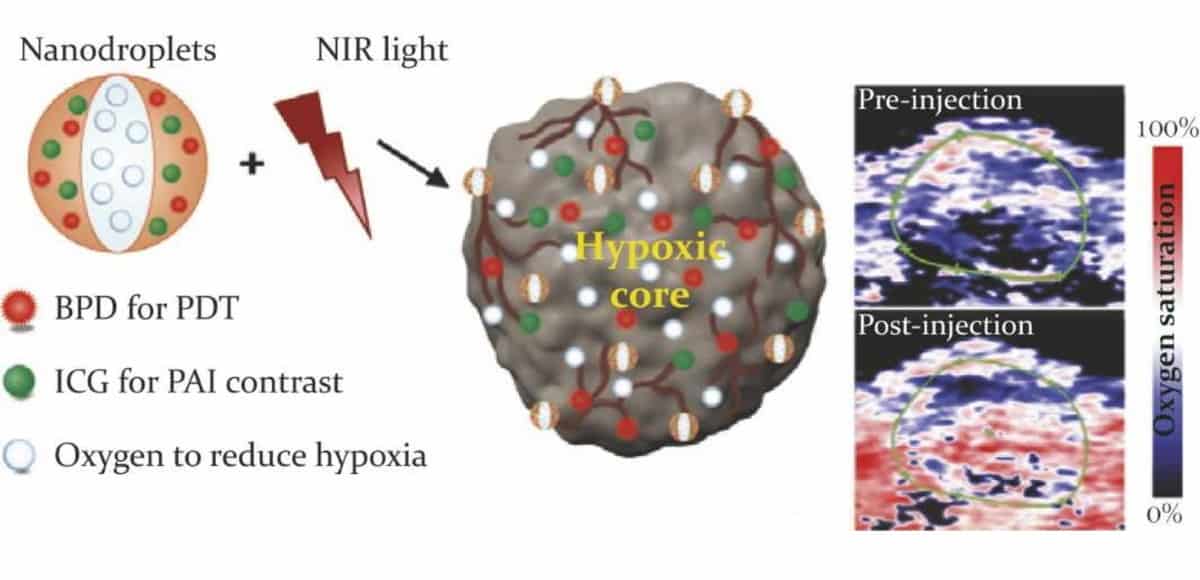 Photoacoustics.
Photoacoustics.
Nanodroplet formulation
First author Marvin Xavierselvan and senior author Srivalleesha Mallidi, from the iBIT Lab and department of biomedical engineering at Tufts University, alongside the team at NanoHybrids, constructed the triple-agent nanodroplets with the aim of enhancing PDT in hypoxic tumours.
The group fabricated nanodroplets containing perfluoropentane (PFP), which has high oxygen solubility and carrying capacity, making it ideal for carrying oxygen. Additionally, previous research showed that the lifetime of singlet oxygen produced after activation of a photosensitizer is longer in PFP than in a cellular environment. Therefore, the researchers believe that PFP nanodroplets could be advantageous for localized delivery of oxygen and photosensitizers.
The nanodroplets also offer the ability to monitor uptake and changes in tumour oxygen levels in real time. To achieve this, the group synthesized nanodroplets containing ICG, an optical diagnostic agent with an absorption peak in the near-infrared (NIR) region. ICG is commonly used as a photoacoustic contrast agent as it absorbs more light than biological tissue in the NIR and generates acoustic waves upon excitation. This signal can be detected by an ultrasound transducer and analysed to determine the level of oxygenation – thereby providing photoacoustic image-guidance.
Absorption of light by ICG can also generate heat, which vaporizes the PFP droplets, leading to localized delivery of the photosensitizer. For this study, the researchers incorporated a benzoporphyrin-derivative (BPD) photosensitizer with characteristic absorption at 690 nm within the nanodroplets.
Nanodroplet function
The researchers demonstrated the nanodroplets’ ability to deliver oxygen in a murine model of head-and-neck cancer. Photoacoustic imaging after injection of nanodroplets showed an overall increase in tumour oxygenation. They also quantified oxygenation within different regions of the tumour before and after nanodroplet administration. This showed that oxygen increase was specific to hypoxic tumour regions, whilst areas of high oxygenation maintained steady levels.
In addition to providing successful oxygen delivery, PFP nanodroplets containing ICG were able to enhance the tumour contrast in photoacoustic images, using an 800 nm light source. This contrast enhancement was also observed in ultrasound images post-nanodroplet administration.
To investigate the efficacy of PDT with oxygen-enriched nanodroplets, the researchers administered PFP, PFP-BPD and PFP-BPD-ICG nanodroplets to mice, with BPD-ICG ratios of 1:1 and 1:2. After irradiating the tumour with a 690 nm laser, they monitored the animals biweekly for up to 15 days.
As expected, no therapeutic response was observed for nanodroplets lacking both BPD and ICG, although a moderate response was observed for nanodroplets containing ICG. “Since ICG has weak absorption at 690 nm, ICG could have been minimally excited and produced a weak photothermal response at this wavelength,” claims Xavierselvan. The therapeutic response in animals receiving PFP-BPD-ICG outperformed that of a clinical photosensitizer, Visudyne, due to its greater singlet oxygen production ability.
Finally, the team note that using BPD-ICG with loading ratios of 1:2 did not produce a therapeutic response – confirming that a higher ICG concentration within the nanodroplets can reduce the therapeutic efficacy of BPD. BPD-ICG loading ratios of 1:1 displayed a significant improvement in treatment efficacy – with a similar outcome to using BPD alone. “When incorporating multiple theranostic agents in a single carrier, it is very important to optimize the loading concentrations of different agents to ensure optimal response,” Mallidi explains.
Future of nanodroplets for oxygen enhancement
The novel nanodroplets have clear benefits for enhancing PDT efficacy by targeting hypoxic tumour regions. “These nanodroplets are made entirely from biocompatible and clinically-approved materials that could potentially enable its transition to the clinic,” says Mallidi.
In the future, the researchers aim to utilize the photoacoustic contrast provided by the nanodroplets to personalize the PDT dose based on the photosensitizer uptake and oxygenation content. The team also envision utilizing these particles within other cancer treatments, such as radiotherapy, where oxygen is a key ingredient for improved efficacy.
